List of mammals of Bangladesh
| Part of a series on |
| Wildlife of Bangladesh |
|---|
 |

This is a list of the mammal species recorded in Bangladesh. There are 89 mammal species in Bangladesh, of which 3 are critically endangered, 12 are endangered, 16 are vulnerable, and 4 are near-threatened.[1]
The following tags are used to highlight each species' conservation status as assessed by the IUCN:
| EX | Extinct | No reasonable doubt that the last individual has died. |
| EW | Extinct in the wild | Known only to survive in captivity or as a naturalized populations well outside its previous range. |
| CR | Critically endangered | The species is in imminent risk of extinction in the wild. |
| EN | Endangered | The species is facing an extremely high risk of extinction in the wild. |
| VU | Vulnerable | The species is facing a high risk of extinction in the wild. |
| NT | Near threatened | The species does not meet any of the criteria that would categorise it as risking extinction but it is likely to do so in the future. |
| LC | Least concern | There are no current identifiable risks to the species. |
| DD | Data deficient | There is inadequate information to make an assessment of the risks to this species. |
Some species were assessed using an earlier set of criteria. Species assessed using this system have the following instead of near threatened and least concern categories:
| LR/cd | Lower risk/conservation dependent | Species which were the focus of conservation programmes and may have moved into a higher risk category if that programme was discontinued. |
| LR/nt | Lower risk/near threatened | Species which are close to being classified as vulnerable but are not the subject of conservation programmes. |
| LR/lc | Lower risk/least concern | Species for which there are no identifiable risks. |
Subclass: Theria
Infraclass: Eutheria
Order: Proboscidea (elephants)
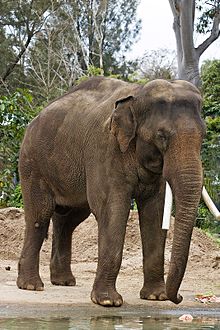
The elephants comprise three living species and are the largest living land animals.
- Family: Elephantidae (elephants)
- Genus: Elephas
- Asian elephant Elephas maximus EN
- Genus: Elephas
- Family: Elephantidae (elephants)
Order: Sirenia (manatees and dugongs)
Sirenia is an order of fully aquatic, herbivorous mammals that inhabit rivers, estuaries, coastal marine waters, swamps, and marine wetlands. All four species are endangered.

- Family: Dugongidae
Order: Primates


The order Primates contains humans and their closest relatives: lemurs, lorisoids, monkeys, and apes.
- Suborder: Strepsirrhini
- Infraorder: Lemuriformes
- Superfamily: Lorisoidea
- Family: Lorisidae (lorises, bushbabies)
- Genus: Nycticebus
- Sunda loris Nycticebus coucang LR/lc
- Genus: Nycticebus
- Family: Lorisidae (lorises, bushbabies)
- Superfamily: Lorisoidea
- Infraorder: Lemuriformes
- Suborder: Haplorhini
- Infraorder: Simiiformes
- Parvorder: Catarrhini
- Superfamily: Cercopithecoidea
- Family: Cercopithecidae (Old World monkeys)
- Genus: Macaca
- Stump-tailed macaque Macaca arctoides VU
- Assam macaque Macaca assamensis VU
- Crab-eating macaque Macaca fascicularis LR/nt
- Northern pigtail macaque Macaca leonina VU
- Rhesus macaque Macaca mulatta LR/nt
- Subfamily: Colobinae
- Genus: Semnopithecus
- Gray langur Semnopithecus entellus LR/nt
- Genus: Trachypithecus
- Dusky leaf monkey Trachypithecus obscurus LR/lc
- Bonneted langur Trachypithecus pileatus EN
- Genus: Semnopithecus
- Genus: Macaca
- Family: Cercopithecidae (Old World monkeys)
- Superfamily: Hominoidea
- Family: Hylobatidae (gibbons)
- Genus: Bunopithecus
- Hoolock gibbon Bunopithecus hoolock EN
- Genus: Bunopithecus
- Family: Hylobatidae (gibbons)
- Superfamily: Cercopithecoidea
- Parvorder: Catarrhini
- Infraorder: Simiiformes
Order: Rodentia (rodents)


Rodents make up the largest order of mammals, with over 40 percent of mammalian species. They have two incisors in the upper and lower jaw which grow continually and must be kept short by gnawing. Most rodents are small though the capybara can weigh up to 45 kg (100 lb).
- Suborder: Sciurognathi
- Family: Sciuridae (squirrels)
- Subfamily: Ratufinae
- Genus: Ratufa
- Black giant squirrel Ratufa bicolor LR/lc
- Genus: Ratufa
- Subfamily: Sciurinae
- Tribe: Pteromyini
- Genus: Hylopetes
- Particolored flying squirrel Hylopetes alboniger EN
- Genus: Petaurista
- Bhutan giant flying squirrel Petaurista nobilis LR/nt
- Genus: Hylopetes
- Tribe: Pteromyini
- Subfamily: Callosciurinae
- Genus: Callosciurus
- Irrawaddy squirrel Callosciurus pygerythrus VU
- Genus: Callosciurus
- Subfamily: Ratufinae
- Family: Spalacidae
- Subfamily: Rhizomyinae
- Genus: Cannomys
- Lesser bamboo rat Cannomys badius LR/lc
- Genus: Cannomys
- Subfamily: Rhizomyinae
- Family: Muridae (mice, rats, voles, gerbils, hamsters, etc.)
- Subfamily: Murinae
- Genus: Bandicota
- Lesser bandicoot rat Bandicota bengalensis LR/lc
- Genus: Leopoldamys
- Long-tailed giant rat Leopoldamys sabanus LR/lc
- Genus: Millardia
- Soft-furred rat Millardia meltada LR/lc
- Genus: Nesokia
- Short-tailed bandicoot rat Nesokia indica LC
- Genus: Niviventer
- Chestnut white-bellied rat Niviventer fulvescens LR/lc
- Genus: Rattus
- Polynesian rat Rattus exulans LR/lc
- Himalayan field rat Rattus nitidus LR/lc
- Tanezumi rat Rattus tanezumi LR/lc
- Genus: Vandeleuria
- Asiatic long-tailed climbing mouse Vandeleuria oleracea LR/lc
- Genus: Bandicota
- Subfamily: Murinae
- Family: Sciuridae (squirrels)
Order: Lagomorpha (lagomorphs)
The lagomorphs comprise two families, Leporidae (hares and rabbits), and Ochotonidae (pikas). Though they can resemble rodents, and were classified as a superfamily in that order until the early 20th century, they have since been considered a separate order. They differ from rodents in a number of physical characteristics, such as having four incisors in the upper jaw rather than two.
- Family: Leporidae (rabbits, hares)
- Genus: Caprolagus
- Hispid hare Caprolagus hispidus EN
- Genus: Lepus
- Indian hare Lepus nigricollis LR/lc
- Genus: Caprolagus
Order: Soricomorpha (shrews, moles, and solenodons)

The "shrew-forms" are insectivorous mammals. The shrews and solenodons closely resemble mice while the moles are stout-bodied burrowers.
- Family: Soricidae (shrews)
- Subfamily: Crocidurinae
- Genus: Crocidura
- Southeast Asian shrew Crocidura fuliginosa LR/lc
- Genus: Suncus
- Asian house shrew Suncus murinus LR/lc
- Anderson's shrew Suncus stoliczkanus LR/lc
- Genus: Crocidura
- Subfamily: Crocidurinae
Order: Chiroptera (bats)
The bats' most distinguishing feature is that their forelimbs are developed as wings, making them the only mammals in the world naturally capable of flight. Bat species account for about 20% of all mammals.
- Family: Pteropodidae (flying foxes, Old World fruit bats)
- Subfamily: Pteropodinae
- Genus: Cynopterus
- Greater short-nosed fruit bat Cynopterus sphinx LR/lc
- Genus: Pteropus
- Indian flying-fox Pteropus giganteus LR/lc
- Genus: Cynopterus
- Subfamily: Pteropodinae
- Family: Vespertilionidae
- Subfamily: Myotinae
- Genus: Myotis
- Whiskered myotis Myotis muricola LR/lc
- Himalayan whiskered bat Myotis siligorensis LR/lc
- Genus: Myotis
- Subfamily: Vespertilioninae
- Genus: Pipistrellus
- Indian pipistrelle Pipistrellus coromandra LR/lc
- Genus: Scotoecus
- Desert yellow bat Scotoecus pallidus NT
- Genus: Scotophilus
- Lesser Asiatic yellow bat Scotophilus kuhlii LR/lc
- Genus: Scotozous
- Dormer's pipistrelle Scotozous dormeri LC
- Genus: Tylonycteris
- Lesser bamboo bat Tylonycteris pachypus LR/lc
- Genus: Pipistrellus
- Subfamily: Miniopterinae
- Genus: Miniopterus
- Small bent-winged bat Miniopterus pusillus LR/lc
- Genus: Miniopterus
- Subfamily: Myotinae
- Family: Rhinopomatidae
- Genus: Rhinopoma
- Lesser mouse-tailed bat Rhinopoma hardwickei LC
- Greater mouse-tailed bat Rhinopoma microphyllum LC
- Genus: Rhinopoma
- Family: Molossidae
- Genus: Chaerephon
- Wrinkle-lipped free-tailed bat Chaerephon plicata LR/lc
- Genus: Chaerephon
- Family: Emballonuridae
- Genus: Saccolaimus
- Naked-rumped pouched bat Saccolaimus saccolaimus LR/lc
- Genus: Taphozous
- Long-winged tomb bat Taphozous longimanus LR/lc
- Genus: Saccolaimus
- Family: Rhinolophidae
- Subfamily: Rhinolophinae
- Genus: Rhinolophus
- Intermediate horseshoe bat Rhinolophus affinis LR/lc
- Genus: Rhinolophus
- Subfamily: Hipposiderinae
- Genus: Coelops
- Tail-less leaf-nosed bat Coelops frithii LR/lc
- Genus: Hipposideros
- Dusky roundleaf bat Hipposideros ater LR/lc
- Indian roundleaf bat Hipposideros lankadiva LC
- Intermediate roundleaf bat Hipposideros larvatus LR/lc
- Genus: Coelops
- Subfamily: Rhinolophinae
Order: Pholidota (pangolins)

The order Philodota comprises the eight species of pangolin. Pangolins are anteaters and have the powerful claws, elongated snout and long tongue seen in the other unrelated anteater species.
- Family: Manidae
- Genus: Manis
- Sunda pangolin Manis javanica LR/nt
- Chinese pangolin Manis pentadactyla LR/nt
- Genus: Manis
Order: Cetacea (whales)
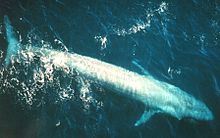


The order Cetacea includes whales, dolphins and porpoises. They are the mammals most fully adapted to aquatic life with a spindle-shaped nearly hairless body, protected by a thick layer of blubber, and forelimbs and tail modified to provide propulsion underwater.
- Suborder: Mysticeti
- Family: Balaenopteridae
- Subfamily: Balaenopterinae
- Genus: Balaenoptera
- Blue whale Balaenoptera musculus EN
- Fin whale Balaenoptera physalus EN
- Bryde's whale Balaenoptera brydei DD[2]
- Eden's whale Balaenoptera edeni DD[3]
- Omura's whale Balaenoptera omurai DD[4]
- Common minke whale Balaenoptera acutorostrata LR/nt[5]
- Genus: Balaenoptera
- Subfamily: Megapterinae
- Genus: Megaptera
- Humpback whale Megaptera novaeangliae VU
- Genus: Megaptera
- Subfamily: Balaenopterinae
- Family: Balaenopteridae
- Suborder: Odontoceti
- Family: Physeteridae
- Genus: Physeter
- Sperm whale Physeter macrocephalus VU[6]
- Genus: Physeter
- Superfamily: Platanistoidea
- Family: Platanistidae
- Genus: Platanista
- Ganges river dolphin Platanista gangetica EN
- Genus: Platanista
- Family: Phocoenidae
- Genus: Neophocaena
- Finless porpoise Neophocaena phocaenoides DD
- Genus: Neophocaena
- Family: Delphinidae (marine dolphins)
- Genus: Steno
- Rough-toothed dolphin Steno bredanensis DD
- Genus: Sousa
- Indo-Pacific humpbacked dolphin Sousa chinensis DD
- Genus: Tursiops
- Indo-Pacific bottlenose dolphin Tursiops aduncus DD
- Bottlenose dolphin Tursiops truncatus DD
- Genus: Stenella
- Pantropical spotted dolphin Stenella attenuata LR/cd
- Spinner dolphin Stenella longirostris LR/cd
- Genus: Lagenodelphis
- Fraser's dolphin Lagenodelphis hosei DD
- Genus: Grampus
- Risso's dolphin Grampus griseus DD
- Genus: Peponocephala
- Melon-headed whale Peponocephala electra LR/lc
- Genus: Feresa
- Pygmy killer whale Feresa attenuata DD
- Genus: Pseudorca
- False killer whale Pseudorca crassidens DD[6]
- Genus: Globicephala
- Pilot whale Globicephala macrorhynchus LR/cd
- Genus: Orcaella
- Irrawaddy dolphin Orcaella brevirostris DD
- Genus: Steno
- Family: Platanistidae
- Family: Physeteridae
Order: Carnivora (carnivorans)
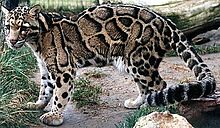
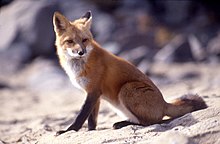

There are over 260 species of carnivorans, the majority of which eat meat as their primary dietary item. They have a characteristic skull shape and dentition.
- Suborder: Feliformia
- Family: Felidae (cats)
- Subfamily: Felinae
- Genus: Catopuma
- Asian golden cat Catopuma temminckii VU
- Genus: Felis
- Jungle cat Felis chaus LC
- Genus: Prionailurus
- Fishing cat Prionailurus viverrinus VU
- Leopard cat "P. bengalensis" NT
- Genus: Catopuma
- Subfamily: Pantherinae
- Genus: Neofelis
- Clouded leopard Neofelis nebulosa VU
- Genus: Panthera
- Indian leopard Panthera pardus fusca NT
- Bengal tiger Panthera tigris tigris EN
- Genus: Neofelis
- Subfamily: Felinae
- Family: Viverridae (civets, mongooses, etc.)
- Subfamily: Paradoxurinae
- Genus: Arctictis
- Binturong Arctictis binturong LR/lc
- Genus: Arctogalidia
- Small-toothed palm civet Arctogalidia trivirgata LR/lc
- Genus: Paguma
- Genus: Paradoxurus
- Asian palm civet Paradoxurus hermaphroditus LR/lc
- Genus: Arctictis
- Subfamily: Viverrinae
- Genus: Viverra
- Large Indian civet Viverra zibetha LR/lc
- Genus: Viverricula
- Small Indian civet Viverricula indica LR/lc
- Genus: Viverra
- Subfamily: Paradoxurinae
- Family: Herpestidae (mongooses)
- Genus: Herpestes
- Small Asian mongoose Herpestes javanicus LR/lc
- Genus: Herpestes
- Family: Felidae (cats)
- Suborder: Caniformia
- Family: Canidae (dogs, foxes)
- Genus: Vulpes
- Bengal fox Vulpes bengalensis LC
- Red fox Vulpes vulpes LC
- Genus: Cuon
- Dhole Cuon alpinus EN
- Genus: Vulpes
- Family: Ursidae (bears)
- Genus: Ursus
- Asiatic black bear Ursus thibetanus VU
- Genus: Helarctos
- Sun bear Helarctos malayanus DD
- Genus: Lutrogale
- Smooth-coated otter Lutrogale perspicillata VU
- Genus: Aonyx
- Oriental small-clawed otter Aonyx cinereus NT
- Genus: Ursus
- Family: Canidae (dogs, foxes)
Order: Perissodactyla (odd-toed ungulates)
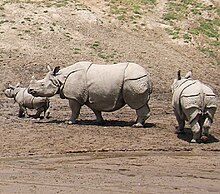
The odd-toed ungulates are browsing and grazing mammals. They are usually large to very large, and have relatively simple stomachs and a large middle toe. They are absent in Bangladesh.
- Family: Rhinocerotidae
- Genus: Rhinoceros
- Indian Sunda rhinoceros Rhinoceros sondaicus inermis EX
- Indian rhinoceros Rhinoceros unicornis VU
- Genus: Dicerorhinus
- Northern Sumatran rhinoceros Dicerorhinus sumatrensis lasiotis EX
- Genus: Rhinoceros
Order: Artiodactyla (even-toed ungulates)


The even-toed ungulates are ungulates whose weight is borne about equally by the third and fourth toes, rather than mostly or entirely by the third as in perissodactyls. There are about 220 artiodactyl species, including many that are of great economic importance to humans.
- Family: Suidae (pigs)
- Family: Cervidae (deer)
- Subfamily: Cervinae
- Genus: Rusa
- Sambar deer Rusa unicolor VU
- Genus: Cervus
- Barasingha Cervus duvaucelii VU
- Genus: Axis
- Chital Axis axis LR/lc
- Genus: Rusa
- Subfamily: Muntiacinae
- Genus: Muntiacus
- Indian muntjac Muntiacus muntjak LR/lc
- Genus: Muntiacus
- Subfamily: Cervinae
- Family: Bovidae (cattle, antelope, sheep, goats)
- Subfamily: Antilopinae
- Subfamily: Bovinae
- Genus: Bos
- Genus: Boselaphus
- Nilgai Boselaphus tragocamelus LC
- Subfamily: Caprinae
- Genus: Nemorhaedus
- Mainland serow Nemorhaedus sumatraensis VU
- Genus: Nemorhaedus
See also
- Wildlife of Bangladesh
- Fauna of Bangladesh
- List of chordate orders
- List of regional mammals lists
- List of prehistoric mammals
- Mammal classification
- New mammal species
Notes
- ^ This list is derived from the IUCN Red List which lists species of mammals and includes those mammals that have recently been classified as extinct (since 1500 AD). The taxonomy and naming of the individual species is based on those used in existing Wikipedia articles as of 21 May 2007 and supplemented by the common names and taxonomy from the IUCN, Smithsonian Institution, or University of Michigan where no Wikipedia article was available.
- ^ Bangladesh Cetacean Diversity Project of the Wildlife Conservation Society. 2015. Proposal to establish a marine protected area in the Swatch-of-No-Ground submarine canyon and surrounding coastal waters in the Bay of Bengal (pdf). Retrieved on March 02, 2017
- ^ IUCN Red List - Balaenoptera edeni
- ^ Cerchio S.. Andrianantenaina B.. Lindsay A.. Rekdahl M.. Andrianarivelo N.. Rasoloarijao T.. 2015. Omura’s whales (Balaenoptera omurai) off northwest Madagascar: ecology, behaviour and conservation needs. DOI: 10.1098/rsos.150301. Retrieved on February 26, 2017
- ^ IUCN Red List - Balaenoptera acutorostrata
- ^ a b 2016. 21 new wildlife species found in Bangladesh
References
- "The IUCN Red List of Threatened Species: Mammals of Bangladesh". IUCN. 2001. Retrieved 22 May 2007. [dead link]
- "Mammal Species of the World". Smithsonian National Museum of Natural History. 2005. Archived from the original on 27 April 2007. Retrieved 22 May 2007.
{{cite web}}: Unknown parameter|deadurl=ignored (|url-status=suggested) (help) - "Animal Diversity Web". University of Michigan Museum of Zoology. 1995–2006. Retrieved 22 May 2007.
